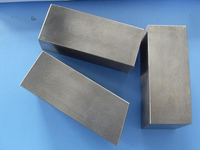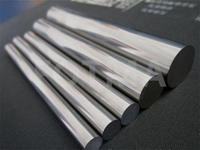Views: 47 Author: Site Editor Publish Time: 2018-01-17 Origin: Site
As a strategic resource, tungsten is widely used in various fields such as national defense and national economy. However, tungsten reserves in the world are extremely small and its protection level is not high. Many countries have placed it on the strategic reserve list and its status is very prominent. This article briefly introduces the distribution of tungsten deposits in the world, the changes of tungsten deposits and the changes in the pattern of supply and demand of tungsten ore. The trends of global tungsten resource supply and consumption in recent 10 years are analyzed. The linear relationship between resource consumption and GDP is used to predict the global tungsten consumption in the next 5 years Continued to increase, China's consumption of tungsten ore will also grow rapidly. Finally, according to the current situation of tungsten resources in the world and the trend of future changes, this paper provides some suggestions and countermeasures for the development of tungsten industry in China from the aspects of tungsten resource advantages, policies, consumption and overseas exploration investment. Hope that through the analysis of this article, to provide some reference value for overseas mineral exploration investment.
"Global tungsten resource supply and demand pattern analysis and countermeasures"
Tungsten is a very important strategic metal, "Industrial Teeth," said. With high melting point, high hardness, high density, good conductivity and thermal conductivity, low coefficient of expansion and other properties, it has important and extensive applications in the fields of aerospace, military, steel, automobile, machinery, petrochemical and mining. Tungsten is mainly used for the production of tungsten carbide and tungsten steel, tungsten and so on. Tungsten metal and titanium, cobalt, tantalum (niobium) and other components for the production of hard alloy cutting tools; tungsten metal and nickel, iron, copper and other metal tungsten alloy is mainly used for aerospace gyroscope rotor, counterweight , Shock absorbers, armor-piercing projectiles of conventional weapons, shielding devices and components for radiation protection, die-casting molds for machinery manufacturing, flywheels and pendulums for automatic watches, contacts and electrodes for electrical equipment, and the like. Some tungsten compounds can be used as fluorescent agents, pigments, dyes and so on. With the development of the global economy and the advancement of science and technology, the application of tungsten has expanded and the demand has been strong. However, the global tungsten resource reserves are extremely low and the protection level is not high. Many countries have placed their names on the strategic reserve list and their status is very prominent.
【1 Tungsten Resources Overview】
【1.1 Tungsten Distribution】
The global tungsten deposits are mainly distributed in two major metallogenic belt, the Pacific Rim metallogenic belt and the Alps-Himalaya metallogenic belt. The large famous tungsten deposits distributed in the Pacific metallogenic belt are Zhuxi in Jiangxi Province, Dahu Tong in Jiangxi Province and Shizhuyuan in Hunan Province Tungsten ore, Sisson, Northern Dancer tungsten in Canada, Nui Phao tungsten in Vietnam, and tungsten in the Pacific Rim metallogenic belt account for more than half of the world total. The Alps-Himalaya metallogenic belt includes large-scale super-large tungsten mines such as Verkhne Kayrakty in Russia, Hemer Don in the United Kingdom, Mittersill in Austria and Barruecopardo in Spain. The world tungsten deposit is dominated by quartz vein type, porphyry type and skarn type. The skarn type tungsten deposit is the most important type of tungsten ore in the world, accounting for 1/2 of the world total reserves.
The tungsten deposits in China are mainly distributed in the Sanjiang W-Sn metallogenic belt, the West Qinling-Qilian metallogenic belt, the Tianshan-Beishan metallogenic belt, the South China metallogenic belt and the North China metallogenic belt. Among them, Nanling mineralization is the most intensive mineralization, many large super-large tungsten deposits concentrated in the metallogenic belt, reserves account for more than 70% of the national reserves. The tungsten deposits in China were mainly formed in the Yanshanian period, accounting for 83% of the total, followed by the Hercynian period of 9%, the Caledonian period of 4%, the Precambrian mineralization period of 2% and the Indosinian period of 2%.
[1.2 tungsten reserves]
Global tungsten resources are concentrated in China, Russia, Canada, the United States, Bolivia, Austria, Portugal and other countries. These seven countries have more than 80% of the world's tungsten resources (Figure 1). Global tungsten reserves in 2004-2014 remained at 3 million tons, while China maintained at 1.8-1.9 million tons. In 2014, the global tungsten reserves were 3.3 million tons, of which China accounted for 1.9 million tons, accounting for nearly 60% of the global total. In 2013, China identified 70.14 million tons of tungsten resources. China's tungsten resources are concentrated in five provinces, namely Hunan, Jiangxi, Henan, Fujian and Yunnan. These five provinces occupy more than 90% of China's tungsten reserves. Including scheelite is mainly located in Hunan, wolframite are mainly distributed in Jiangxi.
【1.3 New Development of Tungsten Ore Exploration
Due to the strategic significance of tungsten, global tungsten ore exploration continues to invest. In 2014, Canada's HDI Group's flagship project Sisson tungsten ore, 3.34 million tons of resources are being raised to plan advanced exploration and commissioning. Jersey Jersey tungsten ore, proven reserves of 5040000 tons, plans to put into operation. Since the implementation of the breakthrough strategy for prospecting, the investment in China's tungsten ore exploration has reached an average of 300 million yuan per year. One of the large-sized tungsten deposits such as Dahu Tong and Zhu Creek have been discovered in succession. In 2014, a large-scale porphyry type tungsten ore was discovered in Hunan. From 2006 to 2013, China identified an increase in reserves of tungsten resources from 5,584,000 tons to 7,040,000 tons and a total increase of 1.43 million tons of reserves, an average annual growth rate of 3.7%. In 2006-2013, China newly identified 2.2484 million tons of tungsten resources and an accumulated annual volume of 303,600 tons, especially the discovery of the large-sized large-sized tungsten ore in Dayu Tang in 2012, which resulted in the newly discovered tungsten ore reserves in 2012 The highest history of 1.016 million tons.
【2 Global tungsten resource supply and demand pattern】
【2.1 Global tungsten supply and demand pattern】
Global tungsten supply and demand pattern from 1974-2014 significant changes have taken place. According to the USGS statistics, in 1974 the world's tungsten ore suppliers came mainly from China, the Soviet Union, the United States, North Korea, South Korea, Thailand, Bolivia and other 14 countries, accounting for up to 94% of the global supply. According to the United States Geological Survey, in 1974, China produced 18,700 tons of tungsten ore and the former Soviet Union produced about 16,800 tons of tungsten ore. In 1974, the world's tungsten consumers mainly came from 11 countries such as the United States, the former Soviet Union, Japan, the United Kingdom and Germany, accounting for 91% of global demand. Among them, the consumption of tungsten in the United States was 16,300 tons, that of the former Soviet Union was 14,900 tons, that of Japan and the United Kingdom Each consumes 6,000 tons and 6,000 tons. The consumption of tungsten resources in France, Germany and Great Britain will reach its peak in 1974. The consumption of tungsten resources in the world mainly concentrates in the United States and Europe. The total global tungsten ore supply 83500 tons, the demand of 82800 tons, appeared in short supply pattern (Figure 2).
【2.2 Global tungsten supply and demand pattern in 2014】
According to the statistics of USGS, significant changes have taken place in the supply and demand pattern of global tungsten ore resources in 2014 and 2014. China is rich in tungsten resources with a supply of 68,000 tons, up to 84.5% and a demand of 34,000 tons, up to 53%. In 2014, the global tungsten supply was concentrated in 98 countries in five countries such as China, Russia, Canada, Bolivia and Vietnam. The global consumption of tungsten was mainly from the United States, China, Japan and Russia in 2014, accounting for the global demand The proportion is as high as 74%, of which Japan consumes 7,000 tons, the United States consumes 4,000 tons and China consumes 34,000 tons. In 2014, the supply and demand pattern of global tungsten resources was more concentrated, from 14 countries in 1974 to 5 countries in 2014. In addition, the global tungsten mine experienced more serious overcapacity, surpassing 20,000 tons and the international tungsten price downturn
The supply of tungsten resources in China has changed dramatically in 30 years. For instance, the supply has changed from 22.6% to 82.5% and the demand has changed from 5.39% to 53%.
【3 Global tungsten production and supply trends
According to the statistics of the USGS and WBMS, since 1910, with the impact of various types of tungsten products, war and economic development, there have been several major increases and declines in the output of tungsten ore, from 3300 tons in 1910 to 2014 Of the 82,400 tons, an increase of 25 times. Since the early 19th century, the application of tungsten high-speed steel appeared. By the birth of the tungsten carbide-based cemented carbide in 1928, there was a sharp increase in the production of tungsten, especially the "war metal" property of tungsten. During the First World War, the Second World War and the Korean War, the output of tungsten surged. From 1961 to 1975, the Vietnam War and the Three Middle East Wars brought the tungsten production to a peak. In 1970, the tungsten output reached 85,600 tons. In the new century, the output of tungsten increased from 34,400 tons in the trough of 2000 to a new high of 82,400 tons in 2014, an average annual growth rate of 8.6%.
According to the statistics of the USGS, from 2004 to 2014, global tungsten production will remain at 50,000-900 tons. In 2014, the world's crude tungsten production was 82,400 tons, with a demand of 64,000 tons and an overcapacity of 20,000 tons. 68,000 tons in 2014, accounting for 83% of the global total. Russia is the second-largest producer of tungsten with 3600 tonnes of tungsten output in 2014; Canada is the third-largest producer of tungsten with 22 million tonnes of tungsten output in 2014; and Bolivia, Vietnam, Australia, Austria, Portugal and the Congo-Gold are also important tungsten producers country. Tungsten has been produced in more than 30 countries around the world. As a result of a large number of Chinese tungsten blindly entering the international market, tungsten prices have dropped and many tungsten producers with small output have been forced to cut production or stop production. In 2014, China, Russia, Canada, Bolivia, Vietnam, five countries, the supply ratio as high as 98%
【4 global tungsten consumption trends】
According to the USGS statistics, global tungsten consumption per capita increased from 2000 to 2014, from 7.51G / person to 13.16G / person, with an average annual growth rate of 5.4%. Among them, the average per capita consumption of tungsten in China is 10-25 g / person, the average per capita tungsten consumption in the United States is 25-35 g / person, and the average Japanese consumption of tungsten is 42-78 g / person. Compared with developed capitalist countries that have completed industrialization, consumption of tungsten resources per capita in China is small. In the eight years from 2006 to 2013, China consumed a total of 998,400 tons of tungsten resources, which has great potential for growth. With the economic rise of India and ASEAN, the global demand for tungsten resources will continue to increase in the future.
Global tungsten consumption in 2000-2014 continued to increase, from 46,000 tons in 2000 to 95,400 tons in 2014, an average annual growth rate of 7.7%. In the light of the linear relationship between resource consumption and GDP, China predicts that tungsten consumption will continue to increase in 2015-2020. In 2015, consumption of tungsten will reach 99.95 tons and consumption of 111.15 tons of tungsten in 2020 will be different from that predicted by Roskill International Inc.
[5 countermeasures and suggestions]
[5.1 increase investment in tungsten exploration, focusing on wolframite; while improving the selection of scheelite technology and technology]
Although China's tungsten reserves are abundant, the proportion of scheelite, which is of low grade and hard to be selected, is increasing. In addition, excessive exploitation and excessive exports lead to the obvious decrease of tungsten resources.
In recent years, some progress has been made in the exploration of tungsten ore. Thanks to the continued investment in exploration, on the one hand, it is suggested that tungsten ore exploration should continue to be heavily invested, with a particular focus on high-grade, readily available wolframite. On the other hand, the cooperation between enterprises and scientific research institutes should be strengthened to improve the technology and process of ore dressing and selection of scheelite, so as to enhance the overall cost advantage of China's tungsten ore.
[5.2 policies on stage to reduce taxes and fees, to resolve overcapacity, mining downturn]
Due to the overcapacity of tungsten ore in recent years, tungsten prices continued to slump. Operating profits of tungsten mines such as Xiamen Tungsten and Zhangyuan Tungsten dropped drastically. Some enterprises are in the process of losing production and losing their production. It is suggested that the state grant the tungsten ore enterprises a preferential period from the policy level to help enterprises to spend the downturn in the mining industry. On the one hand to reduce or even cancel the tariffs on tungsten ore, increase sales of tungsten ore abroad. On the other hand, the appropriate reduction of tungsten resources tax and mineral resources compensation fees, temporarily allow enterprises to use land reclamation bonds to improve the operating efficiency of enterprises.
[5.3 new layout of consumer spending in advance, concerned about the regeneration of tungsten]
China's tungsten consumption peak has not yet come, India and ASEAN will become the main driving force for tungsten consumption in the future, the developed countries rely more and more on recycled tungsten. On the one hand, it is proposed to lay aside tungsten investment in Central Asia and the ASEAN region ahead of schedule. On the other hand, we should pay attention to the utilization and market of recycled tungsten, raise the utilization rate of domestic waste tungsten and tungsten, and appropriately involve in appropriate ways to invest in renewable tungsten market in developed countries. Ease the pressure of growth in China's tungsten consumption in the future, and control the supply of international tungsten ore from downstream to raise the price of tungsten.
5.4 Grab the Belt and Road Initiative to Gain Overseas Resources
Global mining downturn, the market capitalization of tungsten companies is about to bottomed out; the major tungsten producers in Canada and other large tungsten producers are actively welcomeing Chinese investors to invest in super-large tungsten ore projects such as Sisson; the implementation of the "Belt and Road" national strategy along the major tungsten, such as Russia, Vietnam and Turkey Resource-owned countries, which are now an important period for tungsten ore bargain-hunting investment, should maintain a certain global supply, base on the safety of domestic resources, maximize the sharing of overseas resources and strengthen the "going global" efforts of resources. Share important dividends for subsequent industrialized countries such as ASEAN and India. We should actively acquire long-term strategies of high-quality overseas resources as one country and gradually transfer mineral resources and related industries to countries such as Africa, ASEAN and Central Asia.





